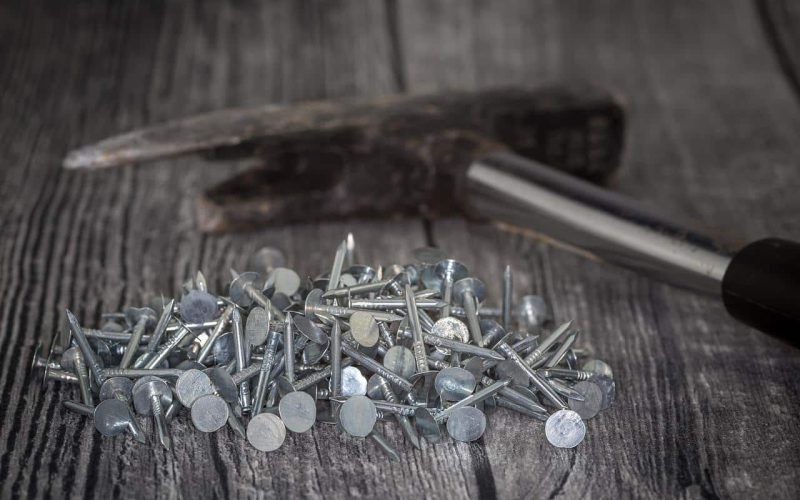Not all roofing nails are the same. There are many types of roofing nails, so selecting the right one can be tricky. Before choosing your nail type, know your project’s requirements.
This can be in cost, length, and quality to get the most bang for your buck (or pound).
Here’s an essential guide to the types of roofing nails on the market to pick the right one!
Different Types of Roofing Nails
1. Aluminum
Aluminum roofing nails are one type of specialty nail used in roofing applications. These roofing nails have a large, flat head and a long, thin shank.
They’re made from aluminum, a soft metal, so they’re not as strong as other types of nails.
However, they’re less likely to split the shingle when driven in and don’t rust, so they’re a good choice for coastal areas or any place where corrosion is a concern.
The roofing nails can be purchased with either anodized or non-anodized heads. Anodized heads are darker than non-anodized ones but may discolor over time. Non-anodized heads will stay silver forever but may get dirty more quickly.
Anodic coated steel: Anodic coated steel roofing nails are a newer style that’s gaining popularity.
The coating on these specialized nails prevents them from rusting like ordinary steel and makes them resistant to high temperatures (up to 800 degrees Fahrenheit).
2. Copper
Copper roofing nails are commonly used for asphalt, wood shingles, and cedar shakes. They’re also famous for slate and tile roofs.
Copper roofing nails’ main advantage is that they won’t rust. This means they have a much longer lifespan than other roofing nails.
Copper roofing nails are also more expensive, so you’ll need to weigh the pros and cons before deciding if they suit your project.
You can find them at home improvement stores like Lowe’s or Home Depot.
They come in coils, which you can buy in bulk and use as needed. You should also be able to purchase them online.
They usually cost about $6 per pound. Remember that using copper roofing nails will require higher expertise because there’s no open head-on end (like with regular wire-nose pliers).
So you may want to bring someone who knows what they’re doing when shopping for these.
Different types of copper roofing nails are also available, such as those with crimped and flared heads (to help keep water out).
The type of nail you choose will depend on how it fits your budget and the durability required for your specific project.
For example, if you live in a coastal area with frequent storms, copper roofing nails may not work because they’re susceptible to saltwater corrosion. But generally speaking, copper roofing nails are great for any residential job.
Regarding insulation, remember that one way to cut down on energy costs is to insulate all attic spaces before installing a new layer of shingles.
3. Ring Shank
A ring shank roofing nail has a series of raised ridges, or rings, around the shank.
These rings increase the surface area of the shank that comes into contact with the sheathing material, making it more difficult for the nail to pull out.
Ring shank nails also tend to have a more giant head than smooth ones, providing more holding power.
Commonly used for asphalt and fiberglass shingles, ring shank nails are available in both coil and strip form.
The downside is that they can be hard to find, depending on your location. Because they’re harder to produce, they can cost up to 10% more than other types of nails.
4. Flat Shank
Flat shank roofing nails feature an enlarged head with two flat sides at a 90-degree angle from each other.
Typically designed for use on boards (shingles), flat shank nails come in lengths ranging from 3 to 8 inches long.
Because these nails are designed for plywood (boards) rather than sheathing, they typically have a thinner gauge and shorter length.
Sometimes, you may want to order these nails online as they may not be available locally.
Another thing to remember is that even though these are among the less expensive types of roofing nails, you will need to purchase them in larger quantities due to their size.
5. Flush Head
Flush head roofing nails look like smooth shank nails, except the head protrudes slightly below the surface of the wood when hammered home.
For this reason, flush heads are commonly known as pop-up nails, as they tend to pop up off the board when hammered tight enough.
Used most often for siding materials such as plywood and OSB, these fasteners are usually about 6 to 12 inches long.
You can choose between a ringed or smooth shank design, but the price is the same. Use ring shanks if you use asphalt or fiberglass shingles and flat shanks if you use boards.
Flush-head nails should only be used for OSB or plywood, as they don’t grip very well against standard sheathing materials.
6. Smooth Shank Nail
A smooth shank nail has a smooth, rounded shaft and is among the roofing nails with this shaft.
These nails are less likely to tear through the roofing material, making them ideal for shingle use.
Soft shank nails are also easier to remove if you need to make repairs later on. Standard sizes range from 3/8 to 1 1⁄2, depending on your shingles’ thickness.
7. Flat Head
Flat-head roofing nails have a flat end and a slightly tapered point at the top, which prevents them from slipping out of your hand when you drive them into your project.
They typically come in 10d or 16d sizes, so read the label before purchasing anything.
8. Crown
A crown nail is an extended version of a ring head nail with its angled end pointing down instead of up and back toward you.
It offers easy hammer-on installation by directing pressure onto one area for increased strength.
How to Choose the Right Nail?
Choosing the right one among the different types of roofing nails is essential because different nails are designed for different types of roofing.
Using the wrong type of nail could damage your roof or cause it to leak. Here are some things to consider when choosing a roofing nail:
- The type of roof you have (shingle, tile, metal, etc.)
- The climate in your area
- The weight and thickness of your shingles
- The size and shape of the head on the nail
- Whether you want a smooth or ring-shank nail
- The length of the nail -Which side of the nail should be hammered down
- If you need galvanizing or stainless steel nails, look for ones that say galvanized or stainless.
- Nails that are too long can rip through the material under them and get stuck, creating an uneven surface that will make water seep through faster. Always use nails that are shorter than 3/4 long.
- Choose a solid head instead of ring shanks if you have metal roofing. Metal roofs usually hold up better with solid heads because they help prevent them from blowing off during high winds.
Conclusion
There are many types of roofing nails on the market, each with benefits and drawbacks.
The type of roofing nail you choose will depend on your specific needs and preferences.
However, all roofing nails serve the same primary purpose: to keep your roof secure and in good condition.
A roofing nail will be perfect for your needs, and many options are available.








